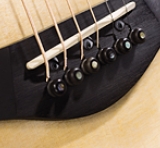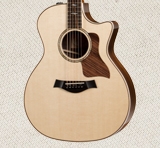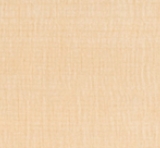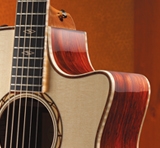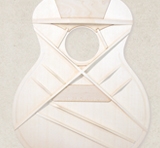-
The Goodnight – Interview
The Goodnight stopped by LA studio, Beta Records for a Taylor Session and a brief interview. -
The Goodnight – Silence
Los Angeles based, The Goodnight dropped by Beta Records to tape a Taylor Session and debut one of their new songs from their… -
Talk About Taylor – Expression System – The Litmus Test
Taylor Guitars luthiers Bob Taylor, Larry Breedlove and Andy Powers, along with Taylor VP of Sales and Marketing Brian Swerdfeger, explain…
314ce
The richness of the solid-wood acoustic experience begins with our 300 Series. Sapele shares mahogany’s lively tonal response and, together with a gloss-finish Sitka spruce top, rings out with a brightness and clarity that give these guitars a definitive Taylor voice. Black binding flanks sapele’s ribbon-like grain, with large pearl fretboard dots adding a traditional touch.
Specifications
Shape Grand Auditorium
Number of Strings 6
Back/Side WoodSapele
Scale length 25-1/2″
Top Wood Sitka Spruce
Body Length 20″
Electronics Expression System 2®
Body Width 16″
Cutaway Venetian
Body Depth 4 5/8″
Nut & Saddle Tusq
Neck Width 1-3/4″
Neck/Heel Tropical Mahogany
Bracing Forward Shifted Pattern with Relief Rout
Fretboard Wood Ebony
Fretboard Inlay 4mm Dots
Headstock Overlay Indian Rosewood
Binding Black
Bridge Inlay None
Bridge Pins Ebony
Tuners Taylor Nickel
Truss Rod Cover Indian Rosewood
Back/Side Finish Satin
Top Finish Gloss
Neck Finish Satin
Pickguard Black
Case Taylor Deluxe Hardshell Brown
Number of Frets 20
Armrest Binding None
Back Config 2-piece No Wedge
Backstrap Wood None
Backstrap Finish None
Brand of Strings Elixir Phosphor Bronze HD Light
Buttons Nickel
Edge Trim None
Fingerboard Ext None
Fretboard Binding Black
Heel Cap Binding Black
Heel length 3-1/2″
Peghead Finish Satin
Peghead Inlay None
Peghead Binding None
Peghead Logo Taylor Colorcore
Peghead Type Standard
Rosette Mat. Plastic
Rosette Size Three Ring
Stain/Sunburst None
Type of Neck Joint Scarf
Wedge None
Media
Grand Auditorium Shape
Body Length: 20″ / Body Width: 16″ / Body Depth: 4 5/8″
Taylor’s signature shape embodies the ultimate all-purpose acoustic.
Our most popular and versatile body shape, the mid-size Grand Auditorium arrived in 1994 bearing refined proportions that fell between a Dreadnought and Grand Concert. While the bigger Dreadnought was traditionally considered a flatpicker’s guitar and the smaller Grand Concert catered to fingerstylists, the GA was designed to deliver on both fronts. The shape produced an original acoustic voice that was big enough to handle medium-strength picking and strumming, yet with impressive balance across the tonal spectrum, especially in the midrange, producing clear, well-defined notes that suited both strumming and fingerstyle playing. The GA’s overall presence tracks well with other instruments both in a studio mix and on stage, and singer-songwriters have embraced its utility both for composing and traveling with one guitar. Many people want a single guitar that can cover a variety of styles, which is why the GA continues to be our bestselling shape. If you want a great all-purpose guitar, the multi-dimensional GA won’t let you down.
Woods
Sitka Spruce
Origin: Northwestern North America (Coastal Rainforests of Alaska and Canada)
Used On: Most models
As a guitar soundboard, or top, Sitka spruce is the tonewood standard of the modern era. It’s used on 85-90 percent of the guitars that Taylor makes. Its combination of strength and elasticity translates into a broad dynamic range, yielding crisp articulation and allowing for everything from aggressive strumming and flatpicking to fingerpicking. Sitka spruce is Bob Taylor’s personal favorite for an all-around great guitar.
Goes Well With: All styles of guitars and players.
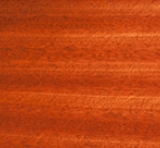
Sapele
Origin: West Africa
Used On: 300 Series, Acoustic 3 Series, Laminate 100 Series, GS Mini, Baby and Big Baby
An alternative tonewood that joined the Taylor fold over a decade ago. It’s sometimes mistakenly referred to as African mahogany because it closely resembles the West African wood khaya, which is commercially known as African mahogany. Sapele is a highly sustainable, relatively fast-growing wood. Tonally, it does everything that mahogany does, with a little extra treble zing. We’ll be able to offer it for a long, long time.
Goes Well With: Everything. Like ovangkol, it’s a great all-purpose tonewood that will deliver a consistent, balanced tone in a variety of playing applications, from fingerstyle to strumming.
CUTAWAY
Venetian
Standard on all “ce” models in the 300 Series through the Presentation Series, the Venetian cutaway is known for its soft, round lines. The sloping peak of the cutaway will vary depending on the shape of the guitar. The Grand Concert, Grand Auditorium, and Grand Symphony have a steeper slope, while the Dreadnought and Jumbo are a bit flatter. Our Grand Concert nylon-string models also feature a subtle, flatter slope, while our 100 and 200 Series cutaway models incorporate our flattest slope.
Forward Shifted with Relief Rout
Inside every Taylor guitar is an important source of its unique sound: bracing. Bracing exists to strengthen the top and back of the guitar, while also allowing enough flexibility and vibration to generate tone. Bracing patterns help “voice” a guitar.
Taylor guitars are known for their balanced tonal response, and our bracing plays a role in that. The way that each brace is shaped and positioned on the soundboard contributes detailed nuances that are so critical that even slight alterations of its design, profile or thickness can result in discernable differences in tone.
You’re likely to hear about “scalloped” bracing, which has become fairly standard on steel-string acoustics. Scalloping is a shaping technique that helps lighten the bracing to prevent it from being excessively bulky, which can restrict top movement.
X Bracing
All of Taylor’s bracing for steel-string models is a form of X-bracing. The “X” provides a continuous flow of strength from the upper bout to the lower bout, which provides rigidity in spite of the soundhole’s location in the middle of the soundboard. We currently offer several versions of X bracing:
Standard X (used on laminate models)
This is Taylor’s original X pattern, featuring scalloped braces. Standard X bracing is used on the Baby, Big Baby, GS Mini, 100 and 200 Series.
Standard II (used on the 300-700 Series)
This version shifts the X forward (closer to the soundhole) and incorporates Taylor’s patented relief rout (see description below). These refinements enable more of the top to vibrate, enhancing the tone.
Advanced Performance (used on the 800 Series)
As part of Taylor’s 2014 voicing refinements for the 800 Series, the bracing profiles and placement were customized for each body shape to optimize their inherent strengths. The bracing scheme also incorporates side braces, which add rigidity and help maximize top and back movement. The overall effect on all the shapes is greater warmth, midrange and sustain.
CV (used on the 900 Series and up)
This version incorporates the relief rout and additional refinements, including subtle contouring differences in the scalloping. In general, guitars with CV bracing sound fuller and fatter without giving up articulation. They are also slightly louder.
The Taylor Relief Rout
Our patented relief rout is a tone-enhancing voicing technique in which a groove is carved along the inside edges of the top. This groove is similar in function to the re-curve on a violin — it “loosens up” the edges of the top, generating extra flexibility without sacrificing structural integrity. We first began using this groove in 2002. The result is increased bass and volume with a balanced tone.
ELECTRONICS EXPSYS2
The new Expression System® 2 captures more of a guitar’s dynamic properties using a breakthrough behind-the-saddle design. 800 Series Story | Taylor Guitars Another tone-enhancing design stroke is a new version of the Expression System pickup, the Expression System 2 (ES2). Taylor pickup designer David Hosler had been studying under-saddle piezo transducers and how they capture a guitar’s energy as it is transferred from the strings through the saddle and soundboard.The industry’s prevailing understanding had been that the top and string vibration cause the saddle to “bounce” up and down.This has long been the basis for the placement of a piezo- electric transducer under the saddle.But Hosler found that the vertical movement is heavily restricted because the string tension’s downward pressure essentially locks the saddle down. That’s why a traditional under-saddle pickup with piezo-electric crystals often responds with a sound often characterized as thin, brittle or synthetic.In reality, the saddle’s natural range of movement is back and forth like a pendulum. That revelation led Hosler to relocate the piezo crystals from under the saddle to behind it, just barely making contact with it. The new positioning enables the crystals to respond more naturally to the guitar’s energy as it was transferred through the saddle. The patent-pending ES2 design incorporates three pickup sensors that are installedbehind the saddle, through the bridge, with three tiny Allen screws that calibrate the pressure of the sensors against the saddle.
